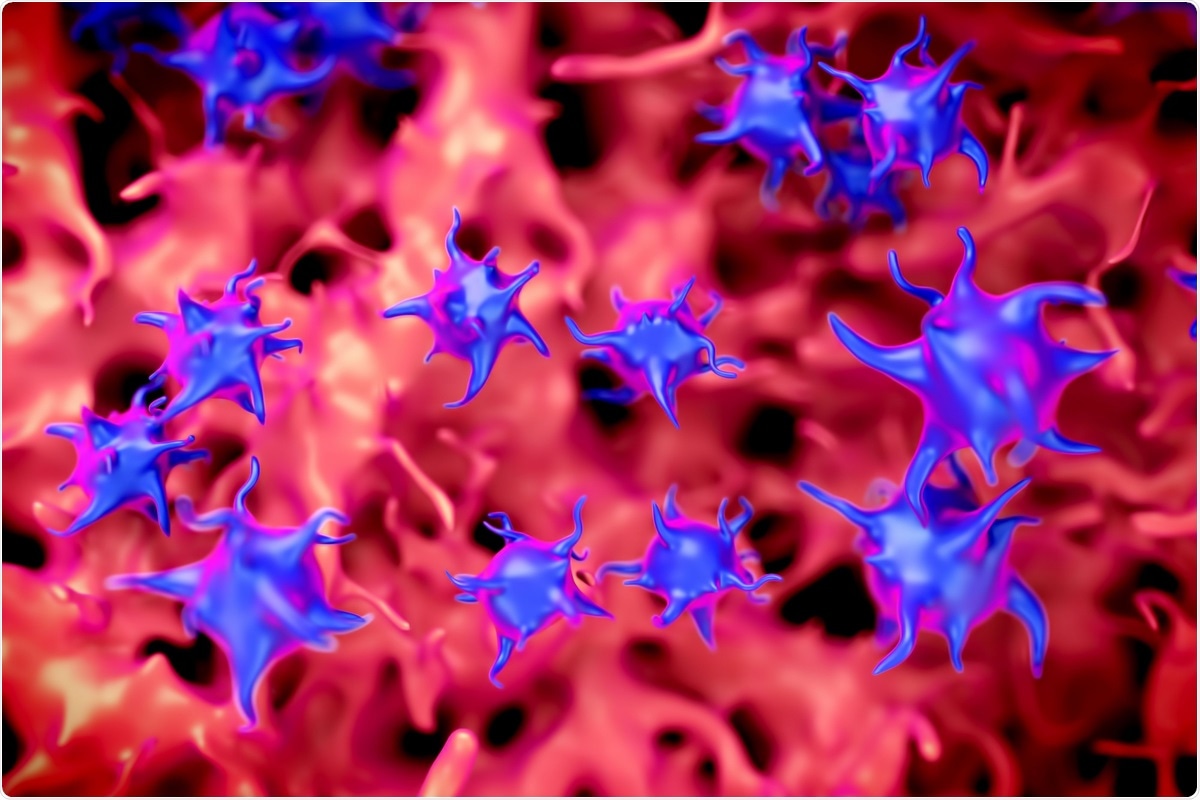The world is experiencing a massive economic and healthcare crisis due to the novel severe acute respiratory syndrome coronavirus 2 (SARS-CoV-2) global outbreak. The rapid worldwide transmission of this virus has caused the coronavirus disease-2019 (COVID-19) pandemic.

SARS-CoV-2 is a single-stranded, positive-sense RNA virus belonging to the family Coronaviridae of the genus betacoronavirus. The major components of this novel coronavirus are nucleocapsid (N), envelop (E), membrane (M), and spike (S) proteins. Scientists have determined that the S protein is primarily responsible for the virus-host interaction and, thereby, virus entry to the cell. The receptor-binding domain (RBD) of the S protein of the SARS-CoV-2 binds with the angiotensin-converting enzyme 2 (ACE2) receptor of the host.
Platelets and COVID-19 infection
Platelets or thrombocytes are involved with hemostasis, thrombosis, and wound healing. Recent studies have also revealed their function in inflammation. Generally, after infection, platelets first bind to infectious pathogens (e.g., bacteria and viruses) and secrete various immunoregulatory cytokines.
They are also involved with the expression of receptors for facilitating various immune responses and regulatory functions. For example, platelets regulate the function of macrophages and T cells and secrete pro-resolving mediators. However, the regulatory mechanisms for both pro-inflammatory and anti-inflammatory regulations are complex and are controlled by the degree of injury and inflammation.
Previous studies have revealed that coronavirus infection initially enhances fibrinogen and D-dimer levels to induce systemic hypercoagulability and frequent venous thromboembolic events. Researchers described this state as a severe pro-inflammatory state associated with triggering pro-coagulopathy through endothelial activation/damage.
Scientists reported an increased presence of circulating activated platelets in COVID-19 infected individuals. This report indicated that platelets were closely associated with COVID-19 severity. However, the role of platelets in the SARS-CoV-2 pathogenesis is not well understood.
COVID-19 vaccines and platelets
In Japan, healthcare workers were prioritized for COVID-19 vaccination, followed by older age groups. Initially, the medical staff received the mRNA BNT162b2 vaccine developed by Pfizer-BioNTech. Soon after, the Moderna vaccine (mRNA-1273) was available for vaccination in Japan. Both these vaccines target the S protein of the SARS-CoV-2 to elicit an immune response.
Since these vaccines mimic the early phase of the SARS-CoV-2 infection, the adverse reactions or the “side effects” are similar to COVID-19 symptoms. Hence, there is a plausibility that the vaccines stimulate platelet activation and degranulation. This, in turn, indicates the possible influence of polyphosphate (polyP) to modify inflammation and immunological reactions.
Polyphosphates (polyP) is one of the platelet regulatory molecules that have gained immense attention as coagulation factors and potent modulators of inflammation. This is a linear polymer of orthophosphate linked by high-energy phosphoanhydride bonds and is stored mainly in platelet-dense granules, which get released upon activation.
Influence of the mRNA vaccines on platelet polyP level
In a recent study published on the medRxiv* preprint server, scientists have tested the hypothesis that indicates the role of polyP in the COVID-19 mRNA vaccine-induced immune responses. Researchers conducted a pilot study to investigate the effect of mRNA vaccines on platelet polyP levels.
Researchers collected blood samples from healthy, non-smoking individuals before and after administration of the BNT162b2 vaccine. The study subjects included six relatively older males and twenty-three young females who were healthy and did not receive any treatment for systematic diseases. Platelets were isolated and were subjected to a fluorometric analysis to estimate platelet polyP levels using 4’,6-diamidino-2-phenylindole. In this study, the side effects of vaccination were documented as scores.
Researchers revealed that after the initial dose of the vaccine, the female group showed a decrease in the platelet polyP levels. However, this result was not seen after the second dose. The older male subjects did not show a reduction in platelet polyP levels
Conclusion
The present study revealed that gender and age play an important role in platelet polyP levels. The authors of this study reported that polyP released from activated platelets could be associated with the suppression of severe side effects after the first dose of mRNA COVID-19 vaccines in young female subjects, which is why they complained of severe side effects after the second dose of the vaccine. The higher immune response was thought to be caused by estrogen. In general, scientists opined that polyp could be considered a marker of the general activity of the immune response.
However, one of the limitations of this study was the limited sample size. Hence, further investigation is required with a substantial sample size to reach a definitive conclusion.
*Important Notice
medRxiv publishes preliminary scientific reports that are not peer-reviewed and, therefore, should not be regarded as conclusive, guide clinical practice/health-related behavior, or treated as established information.
- Uematsu, T. et al. (2021) "Platelet polyphosphate and SARS-Cov-2 mRNA-vaccine-induced inflammatory side effects: a pilot study". medRxiv. doi: 10.1101/2021.09.13.21263437.
Posted in: Medical Science News | Medical Research News | Disease/Infection News
Tags: ACE2, Angiotensin, Angiotensin-Converting Enzyme 2, Anti-Inflammatory, Bacteria, Blood, Cell, Coronavirus, Coronavirus Disease COVID-19, Cytokines, D-dimer, Enzyme, Estrogen, Healthcare, Hemostasis, Immune Response, Inflammation, Membrane, Pandemic, Platelet, Platelets, Protein, Receptor, Respiratory, RNA, SARS, SARS-CoV-2, Severe Acute Respiratory, Severe Acute Respiratory Syndrome, Smoking, Syndrome, Thrombosis, Vaccine, Virus, Wound, Wound Healing

Written by
Dr. Priyom Bose
Priyom holds a Ph.D. in Plant Biology and Biotechnology from the University of Madras, India. She is an active researcher and an experienced science writer. Priyom has also co-authored several original research articles that have been published in reputed peer-reviewed journals. She is also an avid reader and an amateur photographer.
Source: Read Full Article
